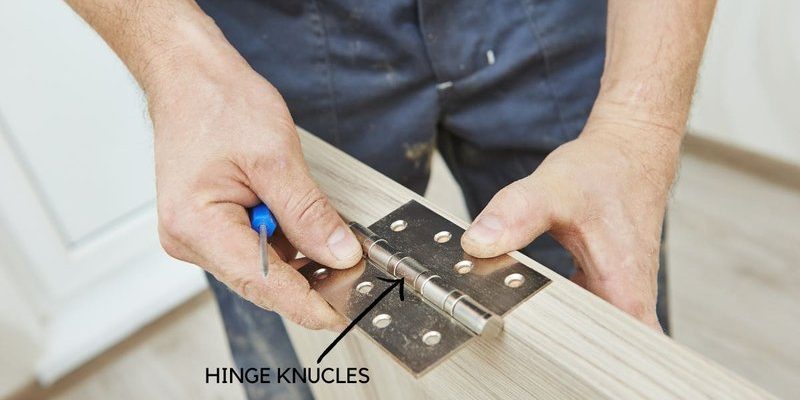
So, what exactly causes this play in hinge knuckles? Let’s break it down. It’s not just a matter of wear and tear; several factors come into play. These can include the material of the hinge, the installation process, and even the weight and usage of the door itself. In this article, we’ll dive deeper into the causes of play in door hinge knuckles and what you can do about it.
Understanding Door Hinge Anatomy
Before we dive into the causes of play, it’s helpful to understand how door hinges are constructed. A standard door hinge consists of a couple of key components: the leaf, which attaches to the door and the frame, and the knuckles, which are the rounded sections that interlock and allow rotation. Think of it like a set of interlocking gears; if one gear is misaligned or damaged, the whole system can become compromised.
The top and bottom knuckles are what actually carry the door’s weight. The more a door is used—opened, closed, or swung—the more these knuckles can wear out over time. If there’s any gap or looseness between them, you might start noticing this play, which can lead to even bigger issues if not addressed.
Why Does Play Occur in Door Hinge Knuckles?
Several factors can lead to excess play in door hinge knuckles. Here’s a closer look:
- Wear and Tear: The most common cause of play is simply age. Over time, materials can degrade, leading to less-than-ideal fit between knuckles. When metal rubs against metal, friction develops, which can create small gaps.
- Improper Installation: If hinges are not installed correctly, they can be misaligned, causing extra stress on the knuckles. It’s a little like trying to fit a square peg into a round hole; it just won’t work well in the long run.
- Weight of the Door: Heavier doors place more strain on the hinges. If the hinges aren’t rated for the door’s weight, or if they were poorly constructed, you’ll likely experience more play.
Recognizing where the play is coming from can help you in troubleshooting the issue effectively.
Signs of Play in Door Hinge Knuckles
Identifying play in the door hinge knuckles is often straightforward, but let’s discuss some signs that could indicate a problem:
- Wobbling Door: If your door has a noticeable wobble when opened or closed, that’s a clear indicator. A well-functioning door hinge should allow the door to move smoothly without giving an unsettling sense of movement.
- Noise: Squeaking or grinding sounds can indicate that the hinge isn’t operating smoothly. This noise can arise from the play in the knuckles, where misalignment occurs.
- Visual Gaps: If you can see space between the knuckles when you look closely, that’s definitely a sign of play. Over time, this can lead to more extensive damage.
Being aware of these signs can save you from more significant headaches down the line.
How to Diagnose Door Hinge Issues
Now you might wonder, “How do I know for sure that it’s the hinge causing the problem?” Here’s a step-by-step way to diagnose the issue:
1. Inspect the Hinges: Start with a visual check. Look closely at the knuckles and see if there’s noticeable wear. If they appear uneven or wobbly, you could have a problem.
2. Check for Lubrication: Sometimes, a simple lack of lubrication can cause noise and movement. Apply some lubricant and see if that helps. If it does, great! If not, keep looking.
3. Assess the Weight: Consider whether the door might be too heavy for the hinges installed. If it is, then upgrading to sturdier hinges may be necessary.
4. Tighten Screws: Often, simply tightening all the screws can alleviate some of the play. Be cautious not to overtighten, though, as this can lead to stripping.
By following these steps, you can quickly get to the root of the issue without too much hassle.
Solutions for Reducing Play in Door Hinge Knuckles
If you’ve diagnosed play in your door hinge knuckles, don’t worry! There are several ways to address the issue:
- Replacement Hinges: If wear and tear are significant, you may need to invest in new hinges. Choose high-quality ones that match the door’s weight and style.
- Re-aligning Hinges: If installation was the problem, you might need to re-align the hinges. Loosen the screws, reposition the hinge, and retighten.
- Adding Shims: For minor adjustments, adding small shims can help stabilize the hinge. This can fill in gaps and make the door fit better.
Each solution will depend on the specific symptoms and your comfort level with DIY repairs.
Maintaining Your Door Hinges
Prevention is always better than cure. Here are some simple maintenance tips to keep your door hinges in top shape:
- Regular Lubrication: Make it a habit to lubricate your door hinges at least once a year. This can significantly reduce wear and keep them operating smoothly.
- Periodic Inspections: Check your door hinges periodically for any signs of wear or play. The sooner you catch an issue, the easier it is to fix.
- Use Proper Hinges: When installing new doors, always ensure you choose the right hinge for the door’s weight. This can prevent future issues.
Taking these steps can help extend the life of your door hinges and keep your doors working smoothly.
Understanding the causes of play in door hinge knuckles not only helps you fix issues but also prevents them from becoming bigger problems. Remember, it all comes down to a combination of factors like wear and tear, installation practices, and the door’s weight. By being proactive—inspecting, diagnosing, and maintaining your hinges—you can ensure that your doors operate as they should. So, take a moment to check your door hinges. You’ll save time, money, and frustration in the long run. After all, who wants a wobbly door?
